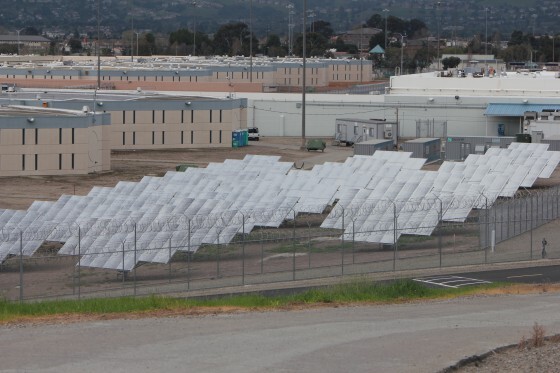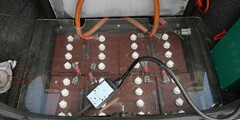Alameda County Jail Builds Microgrid

Photovoltaic panels inside the fence at the Santa Rita Jail in Alameda County | Photo: Lawrence Berkeley Laboratory
If you're a Californian seeking to reduce your fossil fuel consumption, you have a number of ways you can go about it. You could take mass transit, ride a bicycle, or buy a hybrid car. You could insulate your home and get more efficient appliances. You could install rooftop solar.
Or you could hold up a liquor store in Oakland.
As a post by Kevin Bullis in today's MIT Technology Review reports, Alameda County's 4,000-inmate maximum-security jail at Santa Rita has just completed initial work on a distributed energy microgrid, which connects the jail's solar panels, fuel cells, and wind turbines -- as well as more conventional sources of spot power such as diesel generators -- into a system that allows the jail's power to stay on even when the main transmission grid fails.
Related


Explained: Understanding Distributed Generation

What is...? The Grid
Microgrids are an emerging solution to a few consistent problems with electrical power distribution as we know it. They offer reliability in a time where the national grid is becoming incresasingly brittle: a microgrid's operators can keep customers -- or inmates, as the case may be -- provided with power during mass blackouts by simply throwing a switch to disconnect from the larger grid.
They can also save consumers a lot of money, by buying grid power when it's cheapest and running on their own generation capacity during more expensive peak periods. The Santa Rita Jail reports expected savings of $100,000 a year.
Lastly, microgrids offer an incremental solution to the issue of renewable power intermittency: high-tech microcontrollers can regulate fluctuating power flow, and battery storage can provide a hedge against times when the wind dies down and the sun hides behind a cloud. The Santa Rita Jail system runs microcontrollers at each generation site, and industrial lithium-ion storage batteries capable of holding 4 megawatt-hours' worth of power.
With their remotely-controlled locks, surveillance-dependent security and generally disgruntled population, jails are definitely one place where a power outage can lead to utter catastrophe. Field-testing a microgrid at a facility that needs power 24/7 makes perfect sense. But there's something about this test taking place in our incarceration-prone state that gives a bit of an "Only In California" tinge to the Santa Rita Jail's pioneering project.
ReWire is dedicated to covering renewable energy in California. Keep in touch by liking us on Facebook, and help shape our editorial direction by taking this quick survey here.


